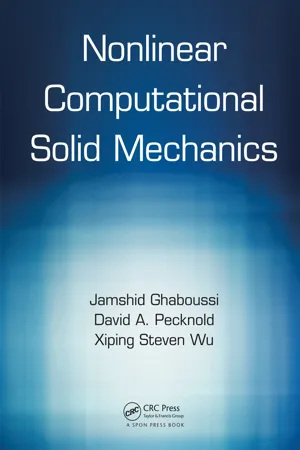Mathematics
Elastic Energy
Elastic energy is the potential energy stored in an object when it is stretched or compressed. This energy is proportional to the amount of deformation and the stiffness of the object. It can be calculated using the formula 1/2kx^2, where k is the spring constant and x is the displacement.
Written by Perlego with AI-assistance
Related key terms
Related key terms
1 of 4
Related key terms
1 of 3
4 Key excerpts on "Elastic Energy"
- eBook - ePub
Integration of Ferroelectric and Piezoelectric Thin Films
Concepts and Applications for Microsystems
- Emmanuel Defaÿ, Emmanuel Defaÿ(Authors)
- 2013(Publication Date)
- Wiley-ISTE(Publisher)
Figure 4.6 , is? The answer must enable us to give a local definition of Elastic Energy density. As a starting point, we can choose a non-null state of stress and strain.The idea is then to determine the change in Elastic Energy when a force f is applied to the infinitely small cube. Here f is small enough for the small strains hypothesis to be valid. The effect of this force on the cube can be replaced by the stress tensor that is applied on the faces of the cube in accordance with what was detailed above.Elastic Energy is equal to the work of the force exerted in the solid.Thus, if we only look in directionThe sum of these contributions is therefore:X1(see Figure 4.6 ), this workδW1is by definition equal to the force (therefore the stress multiplied by the surface area) that is applied on the center of each of the six faces multiplied by the small displacement δU1resulting in directionX1.[4.49]We must see that the stress is considered to be constant on the cube but the displacement is necessarily different depending on the localization in the cube, or the latter would not be deformed but simply displaced. There would therefore not be Elastic Energy stored.Considering the first order in the equation above,δW1becomes:[4.50]Summing their three spatial directions, elastic work δW of the force f becomes:[4.51]withdτ = dX1 dX2 dX3.Thus, the change in Elastic Energy density that is involved in the calculation of internal energy is equal to the work produced by the force f in the solid. To make a direct link with the sections above on energy considerations, we can say that in the adiabatic case (without heat exchange), if we neglect electric energy, the internal energy change is equal to the elastic work. Thus, considering the energy density per unit of volume, we get:[4.52]It is important to note that stress is the intensive variable, like pressure in the case of a gas. Strain, which is considered here as the consequence of stress, is an extensive variable (just like volume for a gas). As the internal energy U by definition differentiates extensive variables, we have dU = TdS - eBook - ePub
- Jamshid Ghaboussi, David A. Pecknold, Xiping Steven Wu(Authors)
- 2017(Publication Date)
- CRC Press(Publisher)
Chapter 12 .Our first inclination is to think of elastic materials as behaving linearly. Although some elastic materials do behave almost linearly over a certain range of deformations, most truly elastic materials are inherently nonlinear. A material is said to exhibit elastic (not necessarily linear) behavior if there are no permanent deformations or residual stresses in any loading and unloading cycle; that is, the stress–strain relations follow the same paths under loading and unloading. A consequence of such a lack of permanent deformation is that there is no history dependency (i.e., memory) in elastic materials; that is, the current state of stress depends only on the current state of deformation.In this chapter and Chapter 6 , we discuss the “mathematical” constitutive laws that are commonly used in computational mechanics. It is important to mention that in recent years, information-based soft computing methods have also been used to capture material behavior. In these approaches, “neural networks” replace mathematical constitutive laws. This topic is discussed in Chapter 12 and in a book on soft computing (Ghaboussi 2017 ).5.2 LINEAR ELASTIC MATERIAL MODELSLinear elasticity is based on the assumption of infinitesimal displacements and strains, which leads to unique definitions of stresses and strains, also recognized as engineering stresses and strains. The material model is expressed through a generalized Hooke’s law given in the following equation in its most general form.(5.1)σ ij=D ijklε klThe tensor of elastic constants Dijkl is a fourth-order tensor that has certain symmetries because of the symmetries of σij and εij . Thus, follow the “minor” symmetries Dijkl = Djikl and Dijkl = Dijlk . The elastic strain energy 2U = σij εij = Dijkl εkl εij , which results in the “major” symmetries Dijkl = Dklij . If Equation 5.1 - Alexander M. Korsunsky(Author)
- 2017(Publication Date)
- Butterworth-Heinemann(Publisher)
Fig. 2.3 ).2.5. Strain Energy Density
The increment of strain energy density (i.e., Elastic Energy per unit volume) in a deforming solid is equal to the work done by the stresses to alter the strains, dU = σ ij dε ij . The relationship between stresses and strains can therefore be expressed in terms of the strain energy density asFigure 2.3 Schematic illustration of continuum mechanics problem formulation.σ=i j.∂ U∂εi j(2.4)Assuming the deformation considered is small, the energy density U may be expanded into Taylor series in terms of strains with respect to the reference state. If this initial undeformed state of the solid is assumed to be stress-free, then at ε ij = 0 there must be σ ij = 0. Hence, the linear terms in the expansion must vanish, and the expression for the strain energy density should contain expressions quadratic in terms of strains,U =U 0+∑i j k l.1 2Ci j k lεi jεk l(2.5)Alongside deformation terms, the total internal energy of a solid contains entropy- eBook - ePub
- Robert Weinstock(Author)
- 2012(Publication Date)
- Dover Publications(Publisher)
5(A specific form for the function W is derived in 10-3(b ) below.) Thus the total potential energy of deformation is given byIf ρ is the density (mass per unit volume) of the body, the kinetic energy of a volume element dx 1 dx 2 dx 3 is , so that the total elastic kinetic energy of the solid is given bySince the components of the body- and surface-force distributions are assumed to depend only upon the variables x 1 , x 2 , x 3 , t and not upon the displacements u 1 , u 2 , u 3 , we may employ the form (60 ) of 6-7 for the integral to be extremized according to the extended Hamilton’s principle. Since we deal with a continuous distribution of mass, the sum in (60 ) of 6-7 must be replaced by the sum of the volume and surface integralsThus the integral which is extremized, according to the extended Hamilton’s principle, by the functions u 1 , u 2 , u 3 describing the actual motion of an elastic solid body isThe extremization is carried out, according to 6-7, with respect to sufficiently regular functions u 1 , u 2 , u 3 which describe the actual elastic configurations at t = t 1 and t = t 2 . Moreover, there may be portions B ’ of the boundary surface B at which the eligible functions u 1 , u 2 , u 3 may be required to possess prescribed values. For an elasticity problem is generally posed as a boundary-value problem wherein at each point of the boundary surface either the three components of the surface-force distribution or the three components of the displacement are given. At those portions B″ of B at which the components of the surface-force distribution are given, no restriction is made upon the surface values of the functions eligible for the extremization; in fact, one result of the extremization process is the derivation of boundary conditions which must be satisfied on B
Index pages curate the most relevant extracts from our library of academic textbooks. They’ve been created using an in-house natural language model (NLM), each adding context and meaning to key research topics.
Explore more topic indexes
Explore more topic indexes
1 of 6
Explore more topic indexes
1 of 4



